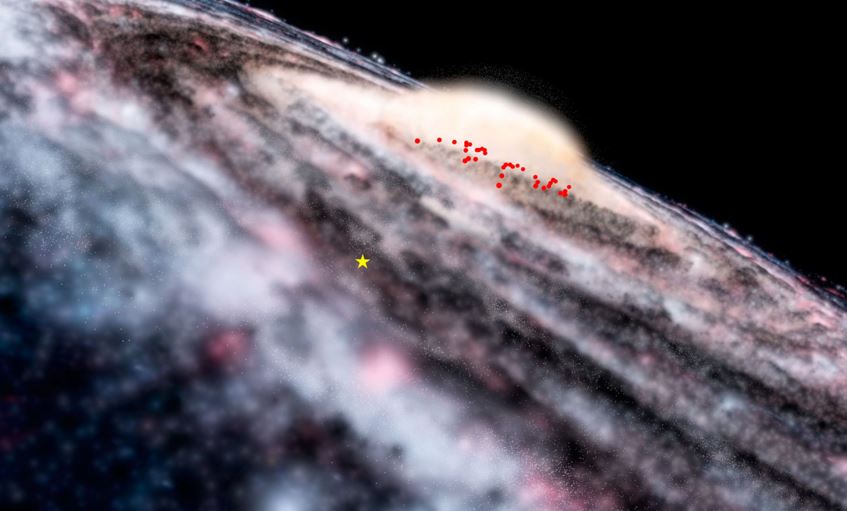Scientists have discovered a group of young stars in a neighborhood of the Milky Way they thought was exclusively occupied by older stars. Experts had believed, until now, that the central bulge of our galaxy was home only to very ancient stars.
This area of our galaxy (Milky Way) was believed to have used up all the raw materials for making new stars a very long time ago – well before these juvenile stars were born.
It appears that the bulge is still creating stars, a team of scientists wrote in Astrophysical Journal Letters.
 Young stars mapped out (red dots) in the center of the Milky Way, where we thought only ancient stars existed (the yellow star is our Sun). (Image: European Southern Observatory)
Young stars mapped out (red dots) in the center of the Milky Way, where we thought only ancient stars existed (the yellow star is our Sun). (Image: European Southern Observatory)
Dante Minniti of the Universidad Andrés Bello, Santiago, Chile, and colleagues gathered and analyzed several years of data from the European Southern Observatory’s Vista telescope in Chile’s Atacama desert. The telescope focused on the dust-obscured center of the Milky Way from 2010 to 2014.
They focused on Cepheids – very large, luminous, yellow stars that change in brightness very regularly with periods of one to seventy days between peaks. The period of their variability provides scientists with a ‘benchmark’ to measure their distance from Earth.
Thirty five young stars detected
However, of the 655 Cepheids that were observed in the center of the Milky Way, thirty-five were ‘classical Cepheids’ – young stars. These stars are much younger than the others residing in the central bulge.
After mapping the stars, the researchers saw they formed a disk right across the center of our galaxy.
The European Central Observatory quotes Istvan Dékány, lead author of the new study, who said:
“The central bulge of the Milky Way is thought to consist of vast numbers of old stars. But the VISTA data has revealed something new — and very young by astronomical standards!”
Extreme dust obscuration (thick dust fog) has historically hindered efforts to map the area along the Galactic mid-plane. Thanks to Vista’s ability to use high-resolution, wide-field imaging at infrared wavelengths, it has been able to look deep into this region.
Dékány said:
“This study is a powerful demonstration of the unmatched capabilities of the VISTA telescope for probing extremely obscured galactic regions that cannot be reached by any other current or planned surveys.”
Dante Minniti said:
“All of the 35 classical Cepheids discovered are less than 100 million years old. The youngest Cepheid may even be only around 25 million years old, although we cannot exclude the possible presence of even younger and brighter Cepheids.”
New stars still being created
This finding is proof that new stars are still being created in the center of the Milky Way, and have been over the past 100 million years, the authors explained.
Further studies are required to determine whether these juvenile stars were created close to where they were detected, or elsewhere (and then moved), the scientists added. In order to find out, they will be using Vista again.
In an Abstract in the journal, the authors wrote:
“The discovered period (age) spread of these classical Cepheids implies a continuous supply of newly formed stars in the central region of the Galaxy over the last 100 million years.”
Citation: “The VVV Survey reveals classical Cepheids tracing a young and thin stellar disk across the Galaxy’s bulge,” I. Dékány, D. Minniti, D. Majaess, M. Zoccali, G. Hajdu, J. Alonso-García, M. Catelan, W. Gieren, and J. Borissova. The Astrophysical Journal Letters, Volume 812, Number 2. October 2015.
Video – VISTA finds hidden feature of Milky Way
